Date: July 17th, 1996
Type: Boeing 747
Registration: N93119
Operator: TRANSWORLD AIRWAYS (D.B.A. TWA)
Where: EAST MORICHES, NY, USA
Report No.:
Report Date: -
Pages: -
This is not an accident investigation report.
On July 17, 1996, about 8:45pm, TWA flight 800, N93119, a Boeing 747-100,
crashed into the Atlantic Ocean off the coast of Long Island shortly after
takeoff from Kennedy International Airport. The airplane was on a regularly
scheduled flight to Paris, France. The initial reports are that witnesses saw an
explosion and then debris descending to the ocean. There are no reports of the
flightcrew reporting a problem to air traffic control. The airplane was
manufactured in November 1971. It has accumulated about 93,303 flight hours and
16,869 cycles. On board the airplane were 212 passengers and 18 crewmembers. The
airplane was destroyed and there were no survivors.
Account of events 17 July 1996
------------------------------
19:59 CVR Recorder Starts
20:18 The flight is cleared for takeoff on runway 22
20:19 Flight TWA 800 took off from Kennedy Airport :
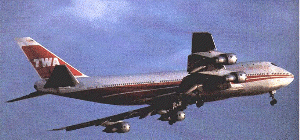
Photo of N93119 taken sometime before it crashed
Air traffic transcript
----------------------
Controller: TWA 800, You have traffic at one o'clock, and seven mile southbound...
Twa 800: TWA 800 heavy, no contact.
Controller: TWA 800, climb and maintain one five thousand.
Twa 800: TWA 800 heavy, climb and maintain one five thousand leaving (one) three thousand.
Eastwind: We just saw an explosion out here, Stinger Bee 507 (Dave McClaine Captain, Eastwind Airlines)
Controller: Stinger Bee 507 I,m sorry I missed it...did you say
something else.
Eastwind: We just saw an explosion up ahead of us here, somewhere about 16,000 feet or something like that. It just went down - in the water.
Virgin: Out of my nine o'clock position , sir, it looked like an explosion of some sort, about maybe.. six miles out from my nine o'clock position.
Controller: Roger that, thank you very much. we're investigating that right now.
Center: TWA 800.. TWA 800, if you hear Center, ident.
Center: TWA 800 center.
Center: TWA 800.. TWA 800, if you hear Center, ident.
Center: TWA 800 center.
Eastwind: I think that was him.
Controller: I think so.
Eastwind: God bless them.
----------------------------------------------------
The following is transcribed directly from a video tape of an interview
with Dave McClaine, Captain piloting a Boeing 737 jetliner "Stinger Bee 507"
(on ATC trancript above) recalling the events he observed on that day. He had just leveled off at 17,000 feet on the plane's commuter run from Boston to Trenton, N.J.
He is the closest eye witness who observed the whole incident.
"So I reached up, took my eye off for a split second, as I grabbed the
left inboard landing light switch and looking at him I flicked it on,
just as I did that it was almost like a direct line from this switch to
the airplane, and it blew."
"The first officer looked up then and saw the explosion and said what
happened, I said it just exploded"
"As he (the controller) started the rollcall my first officer said I
think its TWA800 I said I think you are right."
Captain Dave McClaine(1997):- this interview has been broadcast on television.
At 20:30 is the last radio transmission is received from the aircraft.
The CVR recording stopped at 20:31
The first to be notified of the disaster were the Coast Guard. A US Coast Guard boat with Petty Officer Ken Seebeck and his crew were dispached to the crash scene.
In New York, the Head of the New York FBI Office, Jim Calstrom, was paged as he drove home. He contacted his office and was informed by a duty agent that Flight TWA 800 had crashed in the ocean with early reports of a massive fireball.
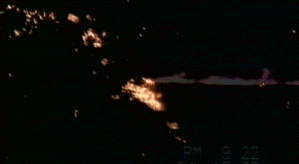
Overhead view of the crash wreakage on the ocean surface
Jim Calstrom immediately went to FBI headquarters New York Office, Operations Centre and Command Post. A team immediately started to chart out the possibilities, a bomb a device, how could it have happened, luggage, mechanics, personnel, passengers. Jim Calstrom spent the night in the command center to oversee the investigation.
By law this was not, at this stage, a FBI case. The investigation of aircraft incidents is carried out by the National Transport Safety Board (NTSB), until a crime is proved.
The NTSB "go" team assembled in Washington for the flight up to Long Island. Al Dickenson was the Investigator in Charge.
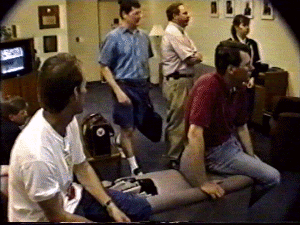
NTSB "GO" team including Bob Swaim (in the shorts)
By the next morning 101 bodies had been recovered from the water. Both Jim Calstrom (Head of the New York FBI Office) and and Dr Bernard Loeb (NTSB Director of Aviation Safety), spoke to the press assembled at Long Island.
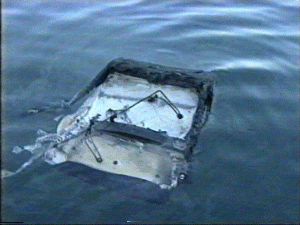
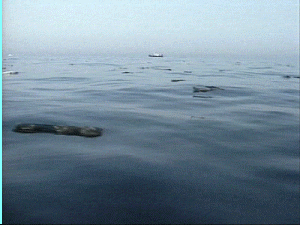
Most of the wreakage sunk to the ocean floor
Over 25 agencies were involved in the recovery, and investigation.
Al Dickenson NTSB remarked of the scene at Long Island "The ratio of Law Enforcement people to NTSB people was about 100 to 1, it was like a scene I had never seen before all these people dressed in white who were examining all the baggage, everything they had found floating around. They had all these tables set up, I had never seen this before, amazing".
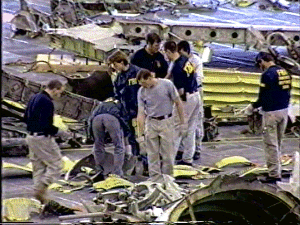
FBI agents examining the wreakage
Operations commenced to recover victims from the ocean floor and at the same time to locate the "Black Boxes".
The black boxes were not recovered until 24th July 1996 at 2:00 am.

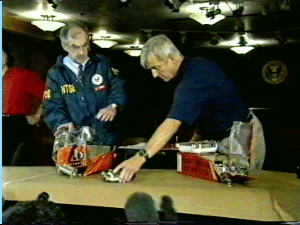
Black Boxes being recovered underwater. "Black" (Red) boxes being displayed to press CVR on left FDR on right.
By 5:00 am the NTSB team had examined the contents of the CVR tape
Cockpit Voice Recorder CVR Investigation Report and Transcript for TWA800 - Click Here -
---------------------------------------------------
Names of a few of those involved in the investigation:
FBI Agents:
Jim Calstrom: Head of New York office
Pam Culos: Special Agent
William J. Tobin Chief Metallurgist
NTSB Agents:
Dr. Bernard Loeb: Director of Aviation Safety
Al Dickenson: Investigator in Charge
Bob Swaim: Investigator
Frank Hilldrup: Investigator
----------------------------------------------------
Conclusions
Conspiracy theorists aside (as there are plenty of web sites dedicated to fiction) it is generally acknowledged that the central fuel tank is were the explosion occurred. The TWA jet had been on the ground for several hours at Kennedy Airport on the hot July day with the air conditioning units running at maximum. One possibility is the air conditioning units combined with the high air temperature made the fuel vapours hot enough to ignite.
Another theory is an electrical short in the scavenge pump for fuel transfer caused the ignition, or shorting in frayed wiring. Failure to pinpoint the exact source of ignition has divided the NTSB and FAA. The NTSB has recommended the filling of empty tanks with an inert gas (for example Nitrogen to expel the oxygen) as the military do with combat aircraft, and therefore prevent and explosion.
Other incidents of fuel tanks exploding have occurred:
11th May 1990 Phillippines B-737 central fuel tank exploded on the ground as it was taxiing, seven passengers died.
9th May 1976 B-747 the Sister plane of TWA800 bought by Imperial Iranian Air Force as a freight transport aircraft, exploded in mid-air near Madrid. Lightning was suspected as having ignited vapour in the fuel tank, however it may have been the same fault as on TWA800.
There is disagreement between the NTSB and FAA as to the approach to reduce the risk of vapour in tanks exploding. The NTSB would prefer that the risk of the vapour exploding be excluded by filling with inert gas as a preventive measure. The FAA's approach is to exclude possible ignition sources. However the FAA is now considering making it mandatory to use JP5 fuel (which has a higher flashpoint) to reduce the chances of explosion on aircraft fuel tanks.
Special Report compiled by David Lisk (c)1999 SkyNet Research
------------------------------------







